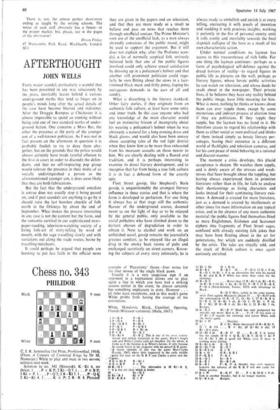Chess no. 343
PHILIDOR
C. J. R. Sammelius (1st Prize, Probleemblad, 1964). (From A Century of Cornered Kings by Dr M.' Niemeijer.) White to play and mate in two moves; solution next week.
Solution to no. 342 (Hancock). K - Kt 6, no
threat 1 .P x KP; 2 Kt-Q 7. 1 ...P X BP; 2 Kt x P.1...P-Q 3; 2 B-Kt 7.1. ..P-Q4; 2 Kt-Kt 4. 1 . . . K x P; 2 R-K 4. PleasanT •
example of 'Piccaninny' theme—four mates for the four moves of the single black pawn.
Usually it is a very suspicious sign if an opponent in a tournament allows one to play again a line in which you have had a striking success earlier in the event; he almost certainly has something unpleasant in store. However . . . all rules have exceptions, and in this week's game White profits from having the courage of his convictions.
White, Matulovic. Black, Camilleri. Opening, French (Winawer variation). (Halle, 1967.)
P — K 4 2 P 3 Kt —Q B 3 B—Kt 5
5 P—QR 3 BXQKtch
6P X B Kt — K 2
7 Q —Kt 4 Q — B 2. This is one of the most contro- versial and critical variations in the game; Black's king's side and White's centre each get smashed. On the whole, it looks as if the balance is in White's favour, if only because he stands better in the endgame with his passed K R pawn. -IA recent example of this was the game Blau-Clarke (Leysin, 1967) where little happened in the early middle ;'game but later on the K R P coat Clarke a piece and the
_ S Q X Kt P R — Kt 1 P x' P
10 K — Q 1 . . . The alternative is 10 Kt —K 2; it is not yet clear which is better.
10..: Kt —Q 2 • 11 Kt —B 3 Kt XP 12 B — K B 4 Q X P` 13 Kt x Kt Q x R ch 14 B —B 1 R-13 1 14...P—Q6; 150 X Pch, K —0 1; 16 Kt X P is an alternative but with his passed K Kt and K R P White has more than value for the exchange.
15 B — Q 3! . . . Better than 15 B — Kt 5 ch, Kt — B 31; 16 R'—K 1 (16 Kt x Kt, B — Q 21), P —R 3; 17 B —R 4, P — Q 6 (Paoli-Schmid. Venice, 1953) with advantage to Black.
15 . . . B — Q 2! Here,, earlier in the same tourna- ment Zinn against Matulovic played 15. Q — Kt 87 with the continuation 16 K — K 2!, Q — Kt 3; 17 B—K R 6, Q— B 2; 18 B — Kt 5 ch. K — Q 1; 19 Kt x P ch,
R X Kt; 20 Q —R 8 ch. Kt — Kt 1; 21 B —Kt 5 ch. Resigns.
16 K — K 2 Kt — B 3? Black has only postponed his mistake one move. Best is 16 . . 0 —0 — 0! but even so 17 Kt x P regains the exchange and leaves White with the better game.
17 Kt X P! . . . Decisive.
17 . . R X Kt. White threatened 18 B — K Kt 5!,
Q X R (18 . , R X Kt; 19 Q — Kt 8 ch); 19 Kt — Q 6 mate.
18 Q — Kt 8 ch R — B 1? 18 . . . K —1C 2 is better but the simple 19 Q X Q R, Q —R 7; 20 Q X Kt P (or B — Kt 5 ch) is good for White even if there is nothing more forcing.
19 B — Kt 6 ch K — K 2
20 Q — Kt 7 ch K — Q 3
21 B — B 4 ch RXB
22 R X Q QR—KB 1
21 P—K B 3 P—K 4 24 K— Q 2 Kt — R 4 25 R —K 1 Kt —B 5 ch 26 K — B 1 P —K 57 A blunder that ends matters;
however the advance of the K R P will win easily for White anyway.
27 B X Pl R — K 1? 27 . . P X B; 28 Q x P ch. Text is another blunder, but it no longer matters.
28 Q — R 6 ch Rftighs.






























 Previous page
Previous page